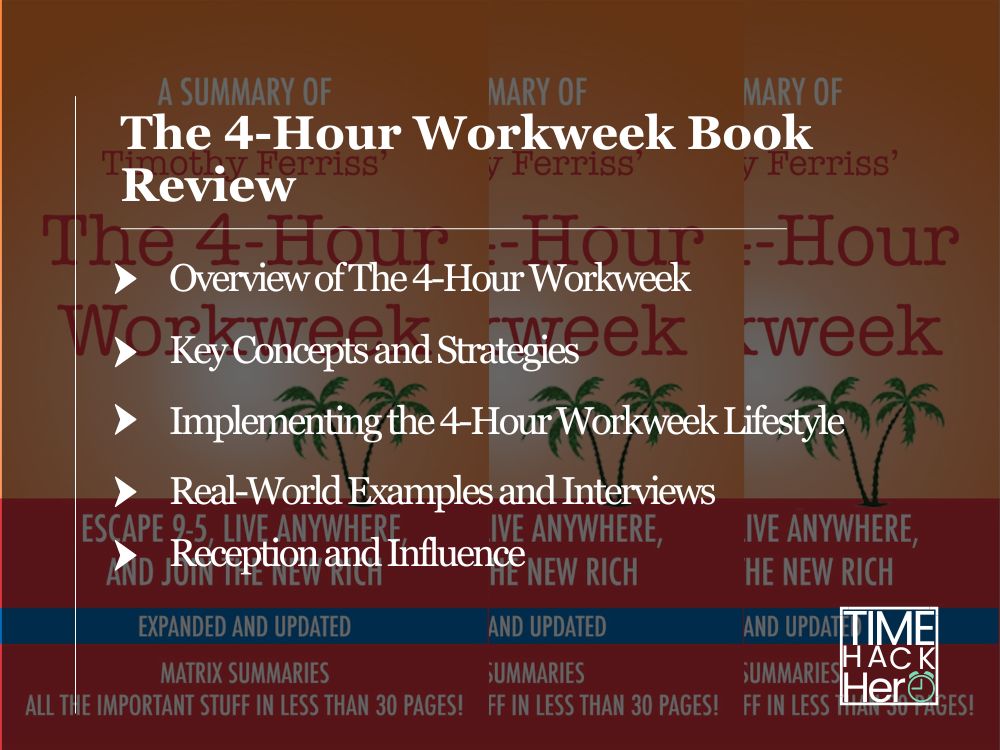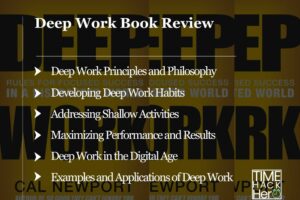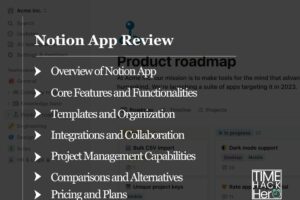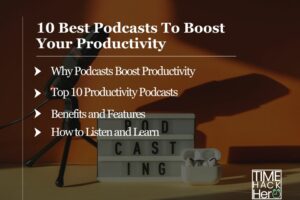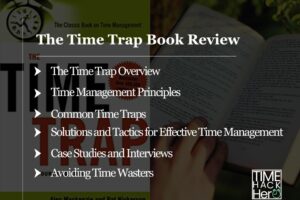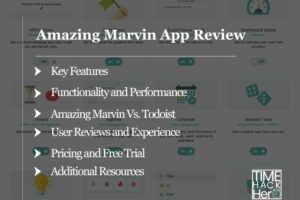The 4-Hour Workweek, written by Timothy Ferriss, has become a groundbreaking bestseller since its publication, offering a new perspective on work-life balance and productivity. The book challenges traditional work models and introduces readers to an unconventional approach, focusing on the idea of working smarter, not harder. Packed with strategies and actionable insights, the book promises to help readers become part of the “New Rich” and gain more control over their time and income.
Ferriss’ concept of the 4-hour workweek revolves around the acronym DEAL, which stands for Definition, Elimination, Automation, and Liberation. Each section outlines specific tips and principles for readers to adopt in their pursuit of a more efficient and fulfilling work-life balance. The book encourages readers to reassess their goals and redefine success while providing practical advice on time management, outsourcing, and creating passive income streams.
Reactions to The 4-Hour Workweek have been mixed, with some praising its revolutionary ideas and others questioning its feasibility for the average individual. Nonetheless, it remains an influential work that has sparked a cultural shift in the way people perceive their careers and seek out alternative paths to success. Regardless of personal opinions on the book’s content, Ferriss’ work has undeniably made a significant impact on the world of entrepreneurship and lifestyle design since its debut on the bestseller list.
Table of Contents
Overview of The 4-Hour Workweek
Author Tim Ferriss
Tim Ferriss is a renowned author who has written multiple bestsellers, including The 4-Hour Workweek, The 4-Hour Body, and The 4-Hour Chef. He has also served as a startup advisor, specializing in positioning, PR, and marketing for companies like Uber and Evernote.
New Rich Lifestyle
The 4-Hour Workweek primarily focuses on enabling readers to achieve a “New Rich” lifestyle. This concept is centered around the idea of abandoning the traditional, deferred-life plan and creating a luxurious lifestyle in the present instead of waiting for retirement. The key to achieving this lifestyle lies in enhancing efficiency, optimizing productivity, and leveraging automation.
The book aims to provide readers with two essential qualities of the New Rich lifestyle:
- More time: The 4-Hour Workweek introduces techniques that allow individuals to maximize their output and minimize their time input, freeing up extra time for personal goals and pursuits.
- More mobility: Ferriss encourages remote work and location independence, allowing people to work from anywhere and experience different cultures and environments.
To summarize, The 4-Hour Workweek by Tim Ferriss is a book dedicated to helping people unlock the New Rich lifestyle by optimizing their work style, time management, and embracing the benefits of location independence.
Key Concepts and Strategies
Pareto Principle
The Pareto Principle, also known as the 80/20 rule, is a key concept in The 4-Hour Workweek. This principle suggests that 80% of results come from 20% of efforts. Author Tim Ferriss encourages readers to focus on identifying and prioritizing the 20% of tasks or activities that generate the most significant outcomes. By doing so, one can achieve higher productivity and better time management.
Outsourcing and Automation
Outsourcing and automation play a crucial role in Ferriss’s strategy. By delegating tasks to virtual assistants, or automating them with technology, individuals can reduce their workload and free up time for more critical tasks. Outsourcing can also help manage mundane or repetitive tasks, thereby improving overall efficiency.
Selective Ignorance
Selective ignorance is another vital concept in The 4-Hour Workweek. It involves purposely choosing not to engage with certain information or distractions, such as excessive email checking or news consumption. By practicing selective ignorance, readers can carefully allocate their attention towards more important and productive tasks, ultimately saving time and increasing productivity.
Mini-Retirements
Lastly, the book highlights the idea of mini-retirements. Instead of waiting for a traditional retirement at the end of one’s career, Ferriss proposes taking multiple breaks throughout a lifetime. These mini-retirements can be spent traveling, learning new skills, or pursuing passions. Incorporating mini-retirements not only helps to prioritize the value of time over money but also allows individuals to enjoy the rewards of their hard work at various stages in life.
Implementing the 4-Hour Workweek Lifestyle
Setting Goals and Defining Success
To successfully implement the 4-Hour Workweek lifestyle, it is crucial to set clear and realistic goals. Start by defining what success means to you, both professionally and personally. Establish short-term and long-term goals that align with your definition of success. This will help keep you focused and motivated throughout the process.
Generating Passive Income
The key to achieving a 4-Hour Workweek is generating passive income streams. Passive income refers to earnings generated with minimal or no ongoing effort. Some common ways to generate passive income include:
- Investing in stocks, bonds, or real estate
- Creating and selling digital products, such as ebooks, courses, or software
- Building and monetizing a website or blog
- Licensing intellectual property, such as patents or copyrighted materials
As an entrepreneur, identify which passive income opportunities best align with your skills, interests, and goals.
Utilizing Virtual Assistants
Leveraging virtual assistants (VAs) is another essential aspect of the 4-Hour Workweek lifestyle. By outsourcing tasks, you can save time and energy for higher priority activities. To effectively utilize VAs, consider the following:
- Determine tasks suited for outsourcing, such as administrative work, data entry, or marketing
- Research and select reliable platforms to find and hire qualified VAs
- Establish clear expectations and maintain open communication with your VA
Avoiding Distractions
To maximize productivity within a shortened workweek, managing distractions is vital. Identify common distractions and develop strategies to minimize them. Tips for avoiding distractions include:
- Establishing a structured daily routine
- Creating a dedicated workspace free from clutter and disruptions
- Prioritizing tasks and focusing on the most important activities first
- Setting boundaries and limiting access to social media or other non-work-related content during work hours
Implementing these strategies can help maintain focus and pave the way for successfully embracing the 4-Hour Workweek lifestyle.
Real-World Examples and Interviews
Case Studies of Successful Practitioners
In the 4-Hour Workweek, Tim Ferriss shares case studies and real-world examples of successful practitioners who have managed to implement the 4-hour workweek lifestyle. He conducted interviews with various individuals who have restructured their lives and careers to achieve the goal of reduced working hours while still maintaining financial success.
One example of such an individual is a person who has built an online business that can be remotely managed. They have outsourced most of their tasks, allowing them to focus on their passion, which is learning tango. By leveraging the power of automation, they can spend more time in Buenos Aires enjoying their newfound freedom.
Moreover, the book discusses the experiences of a community of digital nomads who have turned their backs on traditional 9-to-5 jobs and adopted the principles of the 4-hour workweek. They work diligently for a few hours a day and then focus their energy on leisure, travel, family, or personal projects. Their pursuit of this lifestyle has led to a deeper understanding of the value of time and experiences.
Tim Ferriss’ Personal Experiences
Tim Ferriss shares his own personal journey and transformation from working long hours as a start-up founder to adopting the 4-hour workweek mindset. He narrates his life-changing experience of learning tango in Buenos Aires and how this led him to rethink his priorities and values.
His insights and experiments with outsourcing, automation, and time management have inspired many readers to reconsider their own work-life balance and strive for a more fulfilling existence. By living out the principles he espouses in his book, Tim Ferriss demonstrates the possibility of escaping the 9-to-5 grind and living a more liberated lifestyle focused on the value of time and experiences.
Impact on Work and Life
Remote Work Trends
The 4-Hour Workweek book by Timothy Ferriss has had a significant impact on remote work and work from home culture. With the increasing number of companies embracing remote work, many employees have found new opportunities for flexible working hours and location independence. As a result, more and more people are adopting the concept of lifestyle design, where they can balance their personal and professional lives while working from anywhere. The rise in flexible work arrangements has been beneficial in promoting a healthier work-life balance and decreasing stress levels, reducing the likelihood of burnout.
Achieving Work-Life Balance
One of the core principles of The 4-Hour Workweek is achieving a work-life balance by focusing on the concept of relative income. Ferriss argues that relative income, which takes into account both time and money, is more important than raw earnings. By outsourcing time-consuming tasks and optimizing work processes, individuals can achieve an improved work-life balance. This allows them to spend more time on leisure activities, personal growth, and relationships. The book encourages readers to take “mini-retirements” and to plan their lives around their passions and dreams instead of limiting their plans to the scope of their careers.
Challenges and Potential Drawbacks
While The 4-Hour Workweek has undoubtedly influenced the way people approach their careers and lifestyles, there are potential challenges and drawbacks. Implementing the strategies in the book may not be feasible for everyone, depending on their specific job, industry or personal circumstances. Some critics argue that the book’s ideas often work best for those who are already self-employed or who work in a creative or freelance capacity.
Additionally, remote work and flexible lifestyles may pose challenges for some individuals, such as difficulty in separating work and personal life, feelings of isolation, or the potential lack of a support network. It is essential to carefully consider and address these challenges to ensure a healthy work-life balance while still striving for professional success. Overall, The 4-Hour Workweek can serve as an inspiration for readers, but it is important to remember that each person’s circumstances will dictate how much of the book’s principles can be applied.
Reception and Influence
New York Times Bestseller List
The 4-Hour Workweek, written by Tim Ferriss, was a major success, making it onto the New York Times bestseller list where it stayed, more or less, for the next seven years. This impressive feat showcased the book’s wide-reaching influence and popularity.
Popular Reactions
The book resonated with people looking for alternatives to the traditional 9 to 5 work life. It presented possibilities beyond this grind and emphasized shifting focus from the value of money to the value of time. Many readers claimed that the book changed their lives and helped them redesign their careers and lifestyles.
News Coverage
The 4-Hour Workweek garnered attention not only from readers but also news outlets such as The New Yorker. These publications revisited the book, reflecting on its principles and ideas, further strengthening its position as a powerful thought-provoker in the world of work-life balance and lifestyle designing.
Recommendations
Due to its influence and wide acclaim, The 4-Hour Workweek became a must-read book for people wanting to escape the routine of a typical work life. It received numerous recommendations from successful individuals who endorsed its innovative insights and ideas. With millions of copies sold globally, The 4-Hour Workweek remains a continued cornerstone for personal development and success for those seeking a different approach to their careers.

